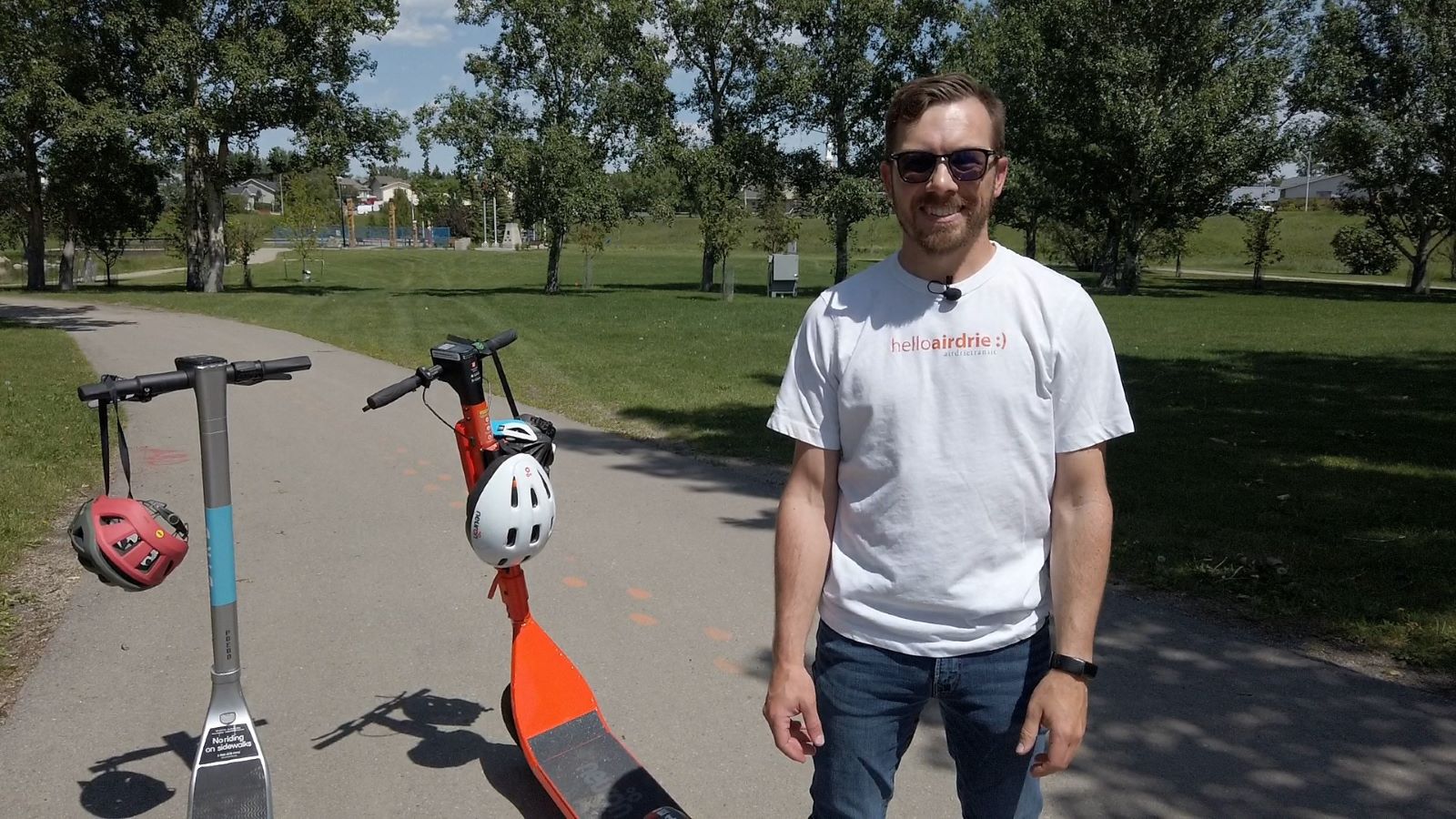Photo caption: City or Airdrie Transit Team Leader Chris MacIsaac.
By now, you’ve no doubt seen the silver and orange e-scooters zipping around city streets, sidewalks, and pathways. And, if it seems like they’re everywhere, it’s because they are.
On June 6, 2022, Airdrie City Council approved the framework for a two-year pilot governing shared modes of micromobility (including e-scooters). The pilot began this past summer and runs to the end of October 2023.
“It’s been very successful for year one of a pilot project,” says Chris MacIsaac, City of Airdrie Transit Team Leader. “Based on what we’ve seen to this point of year one, we’ve been very impressed with the service providers. The community in general has been very supportive of having another transportation option.”
Airdrie currently has two e-scooter providers, Bird Canada (silver) and Neuron Mobility (orange). While the City provides the program framework and awareness campaign, the venture is fully funded and operated by the providers. Each provider has as many as 100 e-scooters in town at any given time, with some fluctuation due to maintenance and charging requirements.
It all started back in the summer of 2021, says MacIsaac. A number of communities were launching e-scooter programs – including Cochrane, Okotoks and Red Deer – when a couple of e-scooter providers approached the City of Airdrie to see if they’d be receptive. And, of course, downtown Calgary was already e-scooter central.
Given Airdrie’s ever-expanding population, and the City’s targets for reducing single-occupant vehicle trips in town, “it made sense for them to come here,” says MacIsaac. “E-scooters fill that gap between driving, taking transit and walking.”
In fact, according to the City of Airdrie website, data shows that municipalities that allow shared e-scooters and micromobility programs reap the following benefits:
- Providing first/last kilometre connections that encourage residents to walk, cycle and use public transit more often;
- Providing options to save time on short trips;
- Improving resident’s physical health that encourages a more physically active lifestyle; and
- Improving access to opportunities (education, employment, recreation) within the community with a mode of transportation that is more inclusive of residents who may face barriers to own/operate a private vehicle.
What made the decision to go ahead with a trial period even more of a no-brainer is the fact there’s no cost to the taxpayer. It’s a ‘user pays’ system where providers earn 100 per cent of their revenue from actual rider use.
“The program has definitely achieved some of the outcomes we wanted,” MacIsaac says, pointing out it’s being used by both recreational users and work commuters to get to those destinations that aren’t directly accessible via transit or too far too walk. “We don’t really keep ridership stats, but you can literally just look and see who’s using them.”
They’re easy to find, service companies geo-track all the scooters and try to keep them in convenient, high-demand, locations; they’re easy to ride (and kind of fun); and it’s easy to create an account, download the app and start e-scooting – if you’re 16 years of age or older.
“Standard single trips will cost C$1.15 to unlock the e-scooter and 42c per minute thereafter,” says Daniel Rodrigo, Alberta Regional Manager for Neuron Mobility. “More frequent users have the option to purchase Neuron Passes, a subscription service, available in three-day ($25), weekly ($33), or monthly C$89) options. The packages will allow users to ride as many times as they want for up to 90 minutes per day for a fixed affordable price.”
According to Rodrigo, a fully charged Neuron e-scooter can go as far as 60 kilometres. Neuron’s e-scooters all have swappable batteries which are changed on site rather than having to transport the e-scooters back to the warehouse to charge them. “We have our patrollers on the ground changing batteries when they get low,” he says. “So the majority of our e-scooters should be charged most of the time.”
“We’re working closely with both providers and the public to determine where there are opportunities for improvement,” says MacIsaac. “We get lots of comments, mostly positive.”
So far, drivers, e-scooter users and pedestrians have done an admirable and very respectful job of obeying the appropriate laws and generally behaving in a safe and courteous manner.
Neuron even has a ScootSafe Academy, an industry-first online rider education platform with city-specific training content, which provides targeted training modules on responsible parking and riding in Airdrie. Riders can earn credits for watching the videos and participating in quizzes and games.
“Most of the complaints we get,” says MacIsaac, “are regarding riders improperly parking scooters when they’re done. We’re always focused on public safety and, right now, parking is our number one issue. As this is the first year, we’ll be outlining some recommendations for Council.”
All the scooters will be collected in late fall (likely the end of October), he says, and will re-appear on city streets in spring 2023.
So, if you haven’t gone for a scoot yet, what are you waiting for?
*Etiquette for micromobility Users
The City of Airdrie is committed to providing convenient, accessible, and efficient transportation choices that support the movement of people and goods throughout our City. To achieve this, we ask all micromobility users (both personal and on shared modes) follow the etiquette listed below:
- Pedestrians First!: Always yield to people walking on the sidewalks and pathways. Pedestrians have priority.
- Be considerate: Use your bell to alert others when you are approaching to pass on sidewalks and pathways.
- Ride Safely: Shared forms of micromobility, including shared e-scooters, are available for users of 16 years of age and older. Helmets are encouraged but not required. The maximum speed limit is 20 km/hr. Only one rider per device is allowed. If you are operating a shared e-scooter on a roadway with a posted speed limit of 30 km/ph or less you are required to use hand signals. The proper hand signals for vehicles can be found by visiting: https://www.alberta.ca/signalling.aspx
- Park Responsibly: Park in a secure, upright position in designated areas (where available) such as at benches, public bike racks or other marked parking zones. On sidewalks without benches or bike racks, please ensure there is at least 2 metres or 6 feet of clearance to allow for accessibility of residents using mobility devices such as a wheelchair.
- Right and report: If you see an e-scooter that has fallen or is parked improperly you can help out your neighbours by righting the e-scooter or you can report this issue to the provider. Contact info for each company is provided on each shared e-scooter.
Improper Shared E-Scooter Parking Concerns
If you come across an improperly parked shared e-scooter from one of the City approved service providers you have a few options.
- You can help out your neighbours by righting the e-scooter (upright with both wheels making contact with the ground and not blocking the sidewalk or pathway).
- You can scan the QR code on the e-scooter via your phone which will allow you to report and send us a photo of the improperly parked e-scooter directly to the provider.
- The e-scooters also have a contact phone number and email address they can reach out to the 24/7 customer service team on.
Personal E-Scooters
Personal e-scooters and other forms of personally owned micromobility, such as e-bikes, have been growing in popularity in our community. There are some important distinctions between personal e-scooters and shared e-scooters/e-bikes.
- Personal e-scooters may be used only on the pathway network.The pathway network is regulated through City bylaws.
- E-scooters on roadways and sidewalks are regulated under the Alberta Traffic Safety Act. Personal e-scooters are not allowed on roadways or sidewalks without a provincial exemption. Currently, shared e-scooters are granted a provincial exemption as the speeds and locations of operation are regulated, and each e-scooter provider is required to have insurance to hold a permit, and other requirements.
*Republished from www.airdrie.ca/escooters





